If you’re a fan of chess, you’ll be intrigued by how the Japanese play the game!
Shogi is Japan’s beloved version of chess, played by military tacticians and warlords for thousands of years.
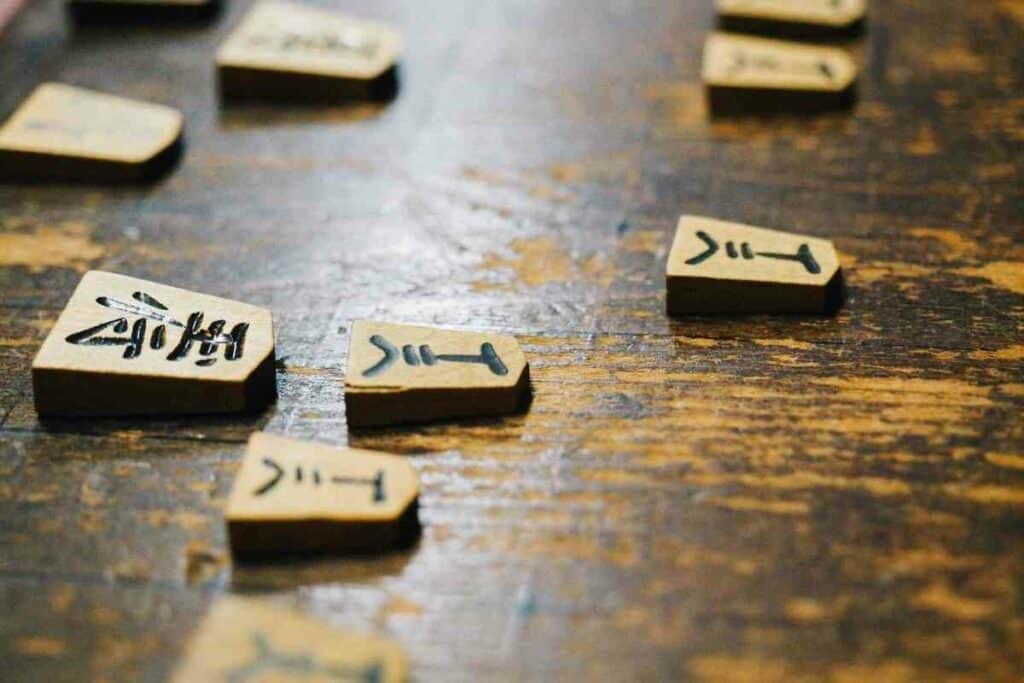
This sophisticated game has a few twists and turns that make it very different from conventional chess and a great challenge!
What to Expect? If you’d like to have a go at playing Shogi, this article takes you through the basics of how to play Shogi, including rules and equipment.
Table of Contents
What is Shogi?
Shogi (将棋) is a Japanese strategy game that is known as the Japanese version of chess.
Like conventional chess, this board game pits two players against one another to capture their opponent’s king.
It is one of the world’s leading traditional chess-like games and part of the family of strategy games that includes:
- Ethiopian Senterej
- Indian chess
- janggi
- chaturanga
- and Xiangqi
Shogi is thought to have developed from an Indian form of chess and transferred to Japan in the Nara period (710 to 794 AD) via Korea and China.
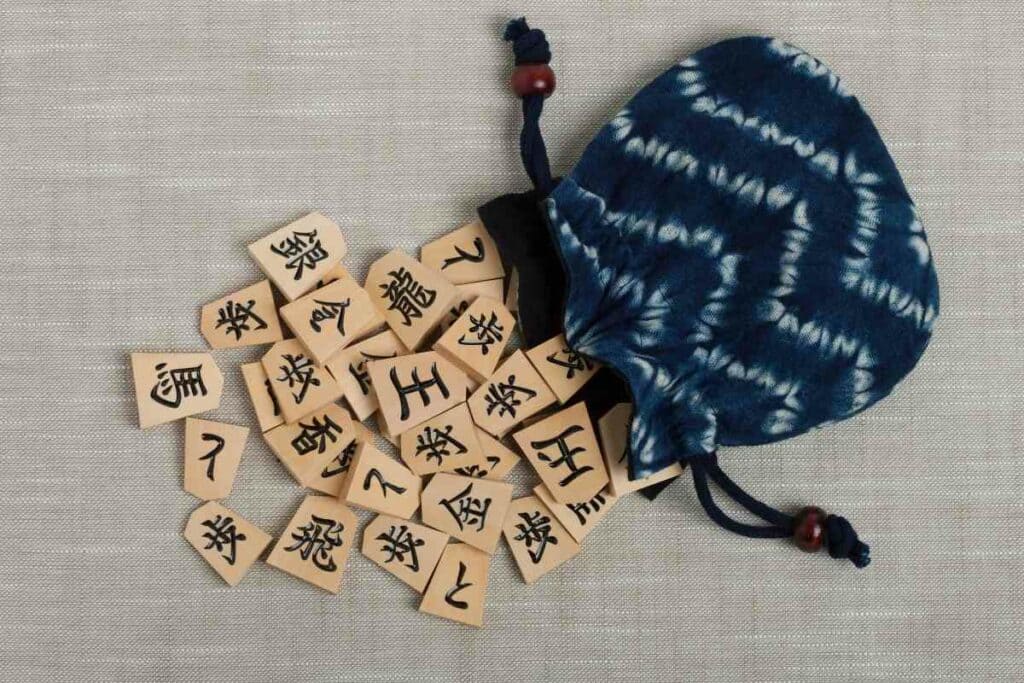
Shogi has a few distinctive twists that have set it apart as one of the most challenging of the chess variants.
The most important feature is that captured pieces can return to the board, playing for the opposing side.
Historians think this unusual feature was introduced by 15th-century Japanese warlords who noted that mercenaries had a tendency to switch sides rather than be killed when captured.
Shogi remains incredibly popular in Japan with at least 20 million people knowing how to play and a million Japanese players.
How to play Shogi
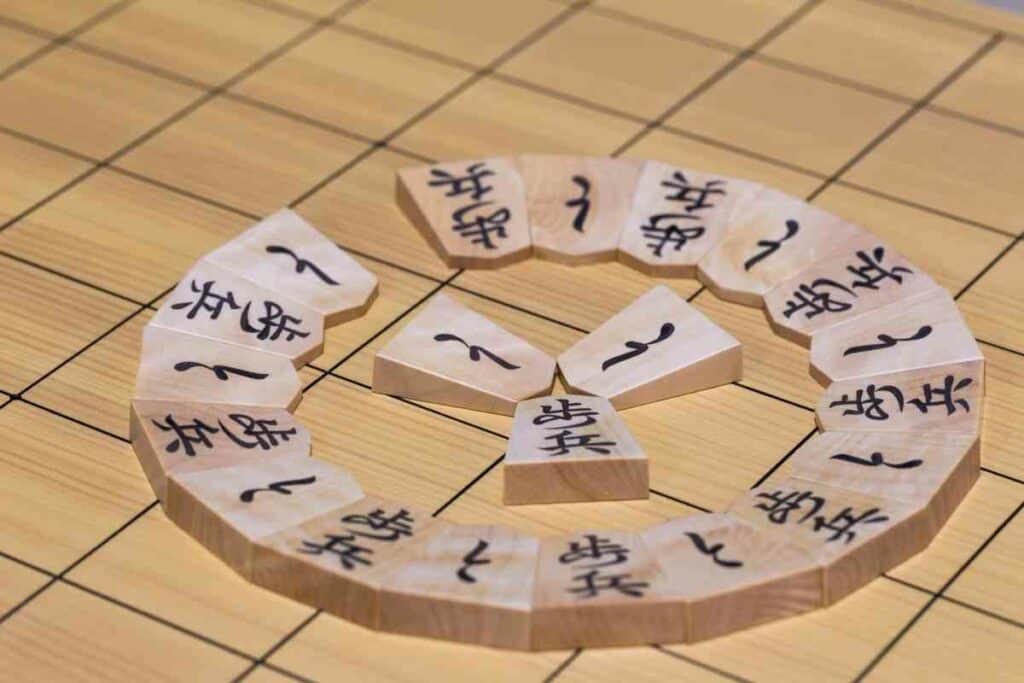
The Shogi board and pieces
Shogi is played on a rectangular gridded board that is larger than a chessboard with 9 rows by 9 columns.
The rows of a Shogi board are called ranks (段) and the columns are called files (筋).
Each player starts the game with 20 pieces.
The pieces are flat pentagonal-shaped pieces of wood or ivory that are inscribed with the name of the piece.
The pieces are broadly analogous to the pieces in conventional chess.
Here are the pieces you start with:
- 9 fuhyō (歩兵). These are Footsoldiers or pawns.
- 2 kyōsha (香車). These are lances or incense chariots.
- 2 keima (桂馬). These honorable horses or katsura horses are the equivalents of knights in chess.
- 2 ginshō (銀将). These are silver generals.
- 2 kinshō (金将). These are gold generals.
- 1 kakugyō (角行), an angle mover or bishop equivalent.
- 1 hisha (飛車), a flying chariot or equivalent of rook or castle.
- 1 ōshō (王将), the jeweled general or King. The challenger player’s king is called a gyokushō (玉将).
Preparing the board for play
In Shogi, pieces are arranged for play over three rows.
Set up your Shogi board by placing the nine pawns in the individual rectangles along the third-furthest row from the player.
The hisha (rook) is placed on the second row one rectangle in on the right and the kakugyō (bishop) in an equivalent position on the left-hand side separated by five empty places.
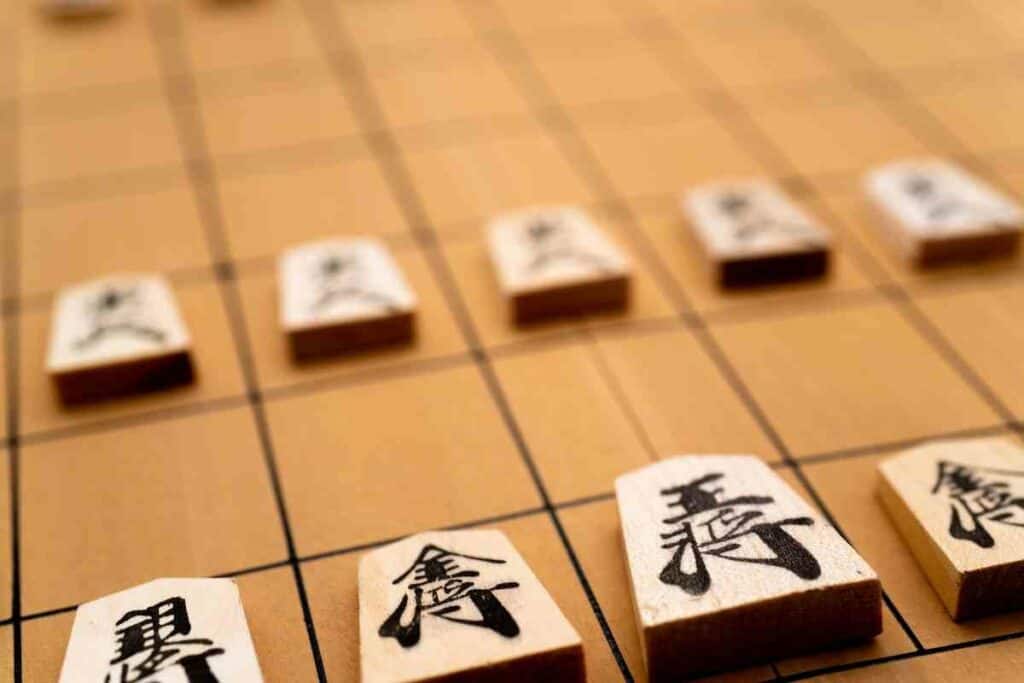
The other pieces line up along the closest rank to the player in the following order: the lances are placed at the two ends followed by the katura horses.
The silver generals are three spaces in from the right-hand and left-hand edges, followed by the gold generals.
The King is placed in the center of this rank between the two golden generals.
The objective of Shogi
Like conventional chess, the goal of the game is to either capture the opponent’s king or place the pieces such that capture is inevitable and the game must be surrendered.
In Shogi – The Kings never leave the board. Also, the game almost always ends with a checkmate because there are always adequate pieces to deliver one as they are never retired from play.
Players cannot agree on a mutual draw, but Shogi matches can end due to:
- either repetition (千日手 sennichite)
- impasse (持将棋 jishōgi)
- or an illegal move (反則手)
If the game is timed, there can also be a time forfeiture.
Playing a game of Shogi
Like chess, players take alternating turns in moving their pieces on the board.
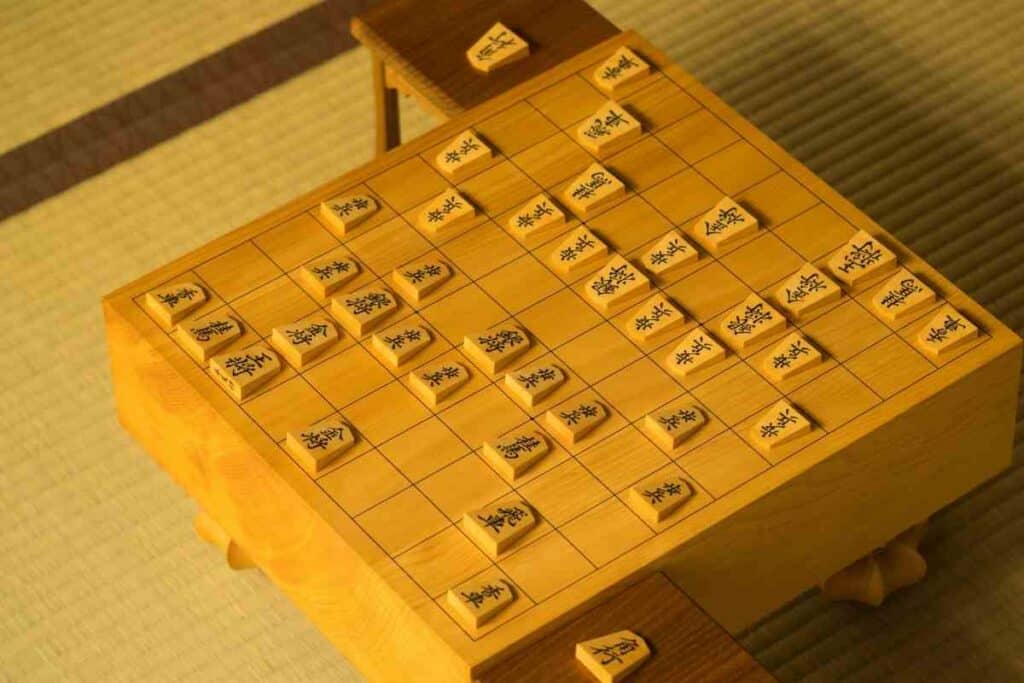
The pieces move according to specific conventions.
No two pieces can occupy the same rectangle. When a piece lands on an opposing piece’s square, the opposing piece becomes “taken”.
Taken pieces are placed on the side of the board in the sight of both players.
How Shogi pieces move on the board
Just like chess, each Shogi piece has its own peculiar movements that can be leveraged for advantage on the board.
This quick table summarizes how individual Shogi pieces move across the board.
| Shogi piece | Moves |
|---|---|
| KING | A King can only move one space in any direction. If the move takes the King towards an opposing piece, the player must seek an alternative direction. |
| Gold General | A Gold general can only move one square at a time. It is allowed to move forward, backward, and horizontally. It can only move diagonally in the forward direction. |
| Silver General | The Silver general has one of five options for moving one square at a time, forward, and diagonally in the forward and backward directions but not to its immediate left or right or directly backward. |
| Angle mover/bishop | The Angle moves just like a regular bishop. It can move any number of squares diagonally unless impeded by another piece. |
| Flying chariot/rook | The Flying chariot can move any number of squares forward or backward unless impeded by another piece. |
| Honorable horses/knights | The Honorable horses move identically to the knights of chess. It can jump over other pieces. It is the only one that can do that. Move your Honorable horses in an “L” shape: two squares forward or backward and one square to the side. This can be forward, backward, or side to side. |
| Lances/incense chariots | A lance moves similarly to a rook but only in the forward direction. |
| Footsoldier/pawn | Like a pawn the footsoldiers only move one square at a time. |
Promoting pieces
In Shogi, pieces can be promoted.
Every piece apart from the Gold General or King can upgrade if they survive making it to the promotion zone!
The promotion zone is basically the last three rows of the opponent’s end of the board.
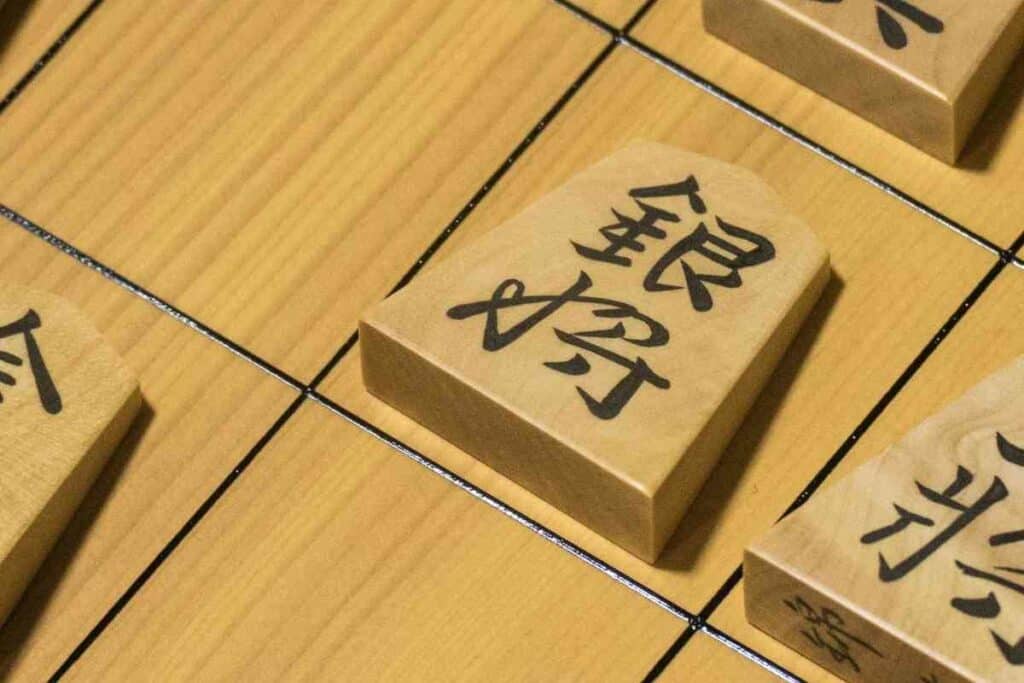
In this area, a player can opt to upgrade their piece.
For the humble footsoldier or lance, promotion is guaranteed. A knight that reaches the penultimate row also earns an upgrade.
You promote Shogi pieces by turning them over. This reveals the symbol of the promoted version of the piece.
Promoted pieces move differently
Promoted pieces really up the ante on the board as they have capabilities that increase the offensive pressure on your opponent.
Here are the superpower moves of promoted pieces.
| Promoted Shogi pieces | Type of movement |
|---|---|
| Pawn, Lance, Knight, and Silver General | These pieces can now move like a Gold General: forward, backward, horizontal, and diagonally forward. |
| A Flying chariot becomes a Dragon king | This promoted piece can move diagonally a single square at time, besides its regular orthogonal movement. |
| An angle mover becomes a Dragon Horse | This promoted piece still moves diagonally like a bishop but can also move orthogonally, one square at a time. |
“Drops” are a peculiarity of Japanese chess
“Drops” are where Shogi departs its Indian chess roots and also why many people consider Shogi to be a superior game.
This term is about the practice of dropping captured pieces onto the board to re-enter the game!
Drops are also termed as “having pieces in hand”, in Japanese mochigoma (持ち駒) or tegoma (手駒).
This is a real game-changer as it means that the game stays lively to the end and stalemates are unlikely.
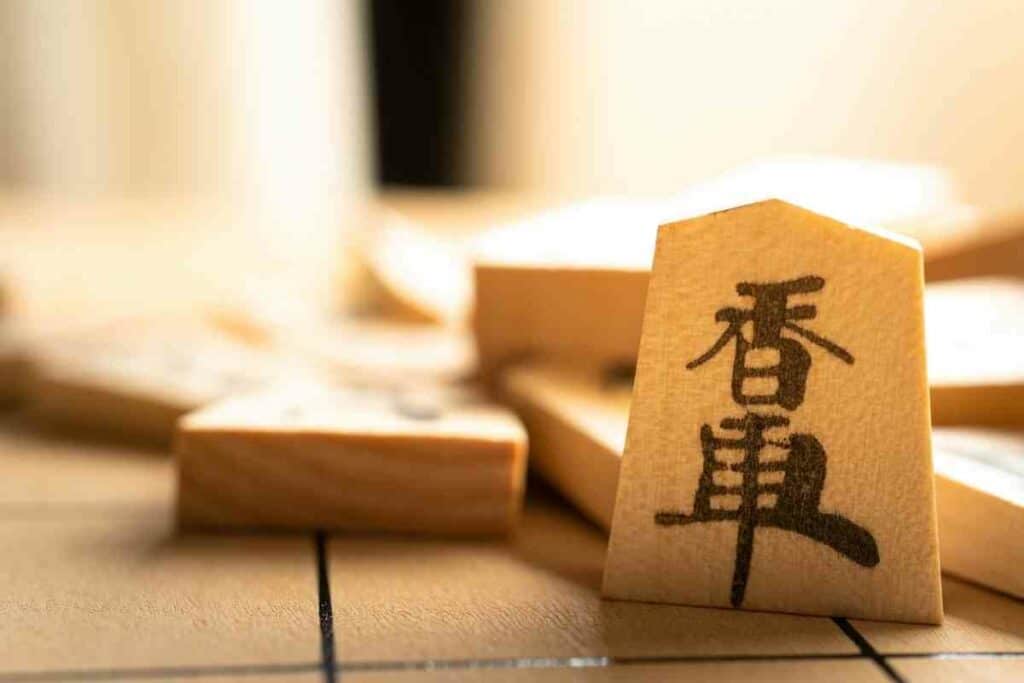
In the traditional Shogi setup, the pieces in hand are placed on dedicated piece stands called komadai (駒台) that sit next to the player by the Shogi board.
Any player who has taken pieces can put them to their use by returning them to the board.
This can happen at any point in the game, with the re-introduced piece being dropped onto any vacant space. One drop counts as a complete move.
The rules surrounding drops are as follows:
- You can only use the dropped piece in its unpromoted state. It must have its unpromoted side up and point towards the opponent’s side. However, if the piece makes it to the promotion zone, you can promote it according to the usual rules.
- You cannot drop pieces onto places that are not part of a legal move for that piece. For example, you cannot drop a footsoldier on the last rank and you can only drop an Honorable horse in the third rank.
- You also cannot drop pawns or lances onto the 9th rank to earn an immediate promotion. They must have at least one subsequent legal move when they are dropped.
- You cannot use a drop to capture a piece, but the piece can be used to capture others on subsequent moves.
- Shogi also prohibits you from dropping a footsoldier onto a file where you have one of your own unpromoted footsoldiers.
- And obviously, you cannot drop any piece in such a way that it causes a King to be immediately checkmated.
Rounding off your game of Shogi
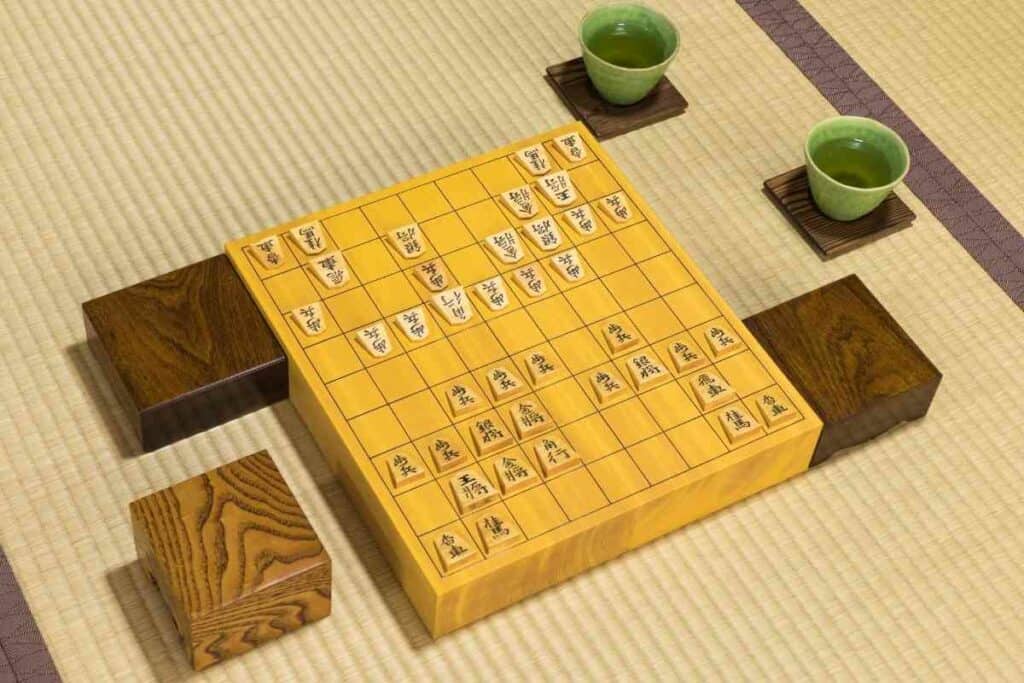
All good things come to an end, and in a tactical game like Shogi, opportunities abound for a definitive win.
Check
In Shogi, check occurs when the opposing King is endangered by your move.
In Japanese, it is called ōte (王手). Once a King is in check, its subsequent move must remove the check.
The king can move away from the threat, use an alternate piece to capture the threatening piece or place an alternate piece in the threat’s path.
In Shogi Tradition – A check is acknowledged and responded to but never spoken. However, modern chess habits have crept into Shogi and people will say “check”.
Ote may be spoken in novice or teaching games but is not a part of advanced gamesmanship.
Checkmate
Shogi players call checkmate tsumi (詰み).
This is where a King is in check with no other move that can deliver the king.
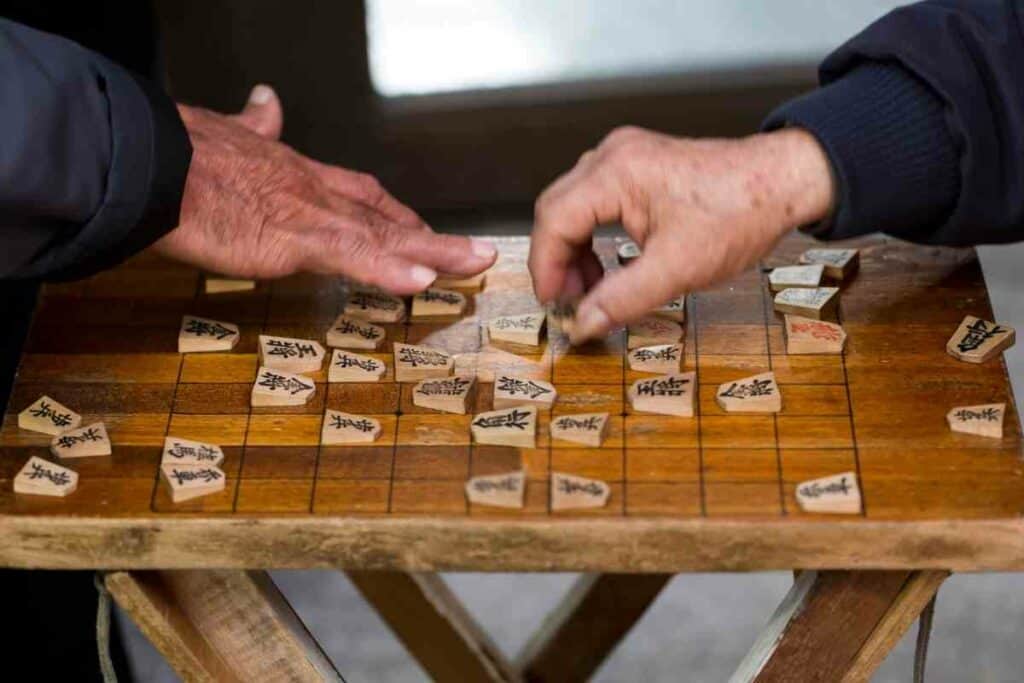
When checkmate occurs, the opponent has won, because there are no other legal moves available.
Checkmate is the main way Shogi games end as the abundance of returned pieces means that a definitive check can be readily achieved.
Resigning a game of Shogi
Shogi games can also be resigned if a checkmate is inevitable.
This can save time. A formal resignation is required as part of the etiquette of a traditional Shogi game.
The defeated player will bow and say makemashita (負けました) which means “I lost”.
Another ancient tradition for resignation is dropping pieces over the board.
Resources for learning more about the game of Shogi
Here are some great links and videos that can help you learn more about how to play Shogi.
Play Shogi online
- Lishogi.org: a basic website where you can play Shogi live online with enthusiasts from around the world.
- PlayShogi: a great website for beginners with lots of tutorials to help you master the game.
Shogi associations
Shogi on YouTube
These channels will teach you how to play Shogi:
Rounding up
Shogi is a challenging and satisfying game, and it is easy to see why it has endured.
Like chess, the different strategies and plays could take a lifetime to master, but learning this game of skill and strategy is a great mental workout and well worth trying.
- The Forbidden Japanese Island That Will Give You Nightmares
- Miss Japan Forced to Wear Sailor Moon Costume Since Childhood: Claims It’s the Secret to Her Success
- Essential Guide to Japan VPN: Secure Access and Privacy for Travelers
- Sumo Wrestler Suit for Adults by TOLOCO: Best Sumo Suit?
- Eki Stamp Book (Gotta Collect Them All!)
- Explore the Fascinating World of Japanese Rubik’s Cubes









